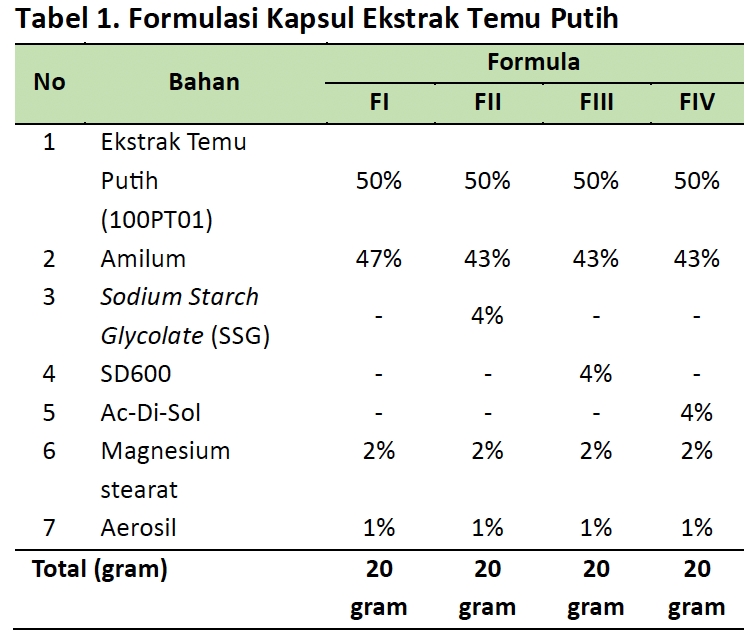Optimization of White Turmeric Extract Capsule Formula (Curcuma zedoaria) using Variations of Disintegrating Agents
DOI:
https://doi.org/10.36733/usadha.v4i1.10526Keywords:
Disintegrating agent, Capsule, White turmeric extractAbstract
Cancer is one of the most common causes of death in the world. Based on data from the World Health Organization (WHO), the number of cancer patients worldwide increases by 6.25 million people, or about 12% of the global population each year. White turmeric contains turmerone, essential oil, and curcuminoids. Curcuminoids have activity against P-388 murine leukemia cells and can inhibit the growth of cancer cells. One of the solid pharmaceutical preparations that is often used is capsules. Capsules require a quick disintegration time immediately after swallowing, and they must be absorbed in the digestive tract to provide bioavailability effects. Therefore, additional materials are needed for the capsule to dissolve quickly after contact with gastric fluid. The population in this study consists of disintegrating agents with various brands. The samples used were sodium starch glycolate, Ac-Di-Sol, and SD600 with a concentration of 4%. The research used an experimental method with a post-test control group design, with four formulations with different disintegrant materials. (sodium starch glycolate, Ac-Di-Sol, dan SD600). The research results show that all formulations meet the requirements for physical quality tests of capsules except for the flow rate test. There is a significant difference between the disintegration time of formula 3 with SD600 and the disintegration time of formula 4 with Ac-Di-Sol. Formula 4 with the disintegrant Ac-Di-Sol has the fastest disintegration time, 15.70 minutes. The factors that influence the results are the moisture and hygroscopicity of the powder.
References
[1] Rahmawati A. Sumber informasi tentang deteksi dini kanker serviks pada wanita pasangan usia subur. J Ilm Kebidanan. 2015;6:74–84.
[2] Wati I, Partiwi VD, Musadi MR. The extraction of curcuminoids from ethanol extract of yellow turmeric (Curcuma longa L) and activity test on P-388 murine leukemia cells. Elkawnie. 2022;8(1):68. doi: 10.22373/ekw.v8i1.10720.
[3] Putri R, Mursiti S, Sumarni W. Aktivitas antibakteri kombinasi temu putih dan temulawak terhadap Streptococcus mutans. J MIPA. 2017;40(1):43–47.
[4] Rahmawati Y, et al. Review artikel studi fitokimia dan farmakologi temu putih (Curcuma zedoaria). J Pharm Sci Technol. 2023;4(1):268–275. doi: 10.30649/pst.v4i1.54.
[5] Chiuman L. Kunyit putih: khasiat antioksidan bagi kesehatan [Internet]. Medan: Universitas Prima Indonesia; 2021 [cited 2024 Oct 14]. Available from: http://jurnal.unprimdn.ac.id/index.php/ISBN/article/download/2646/1656
[6] Sagita ND, Sopyan I, Hadisaputri YE. Kunir putih (Curcuma zedoaria Rocs.): formulasi, kandungan kimia dan aktivitas biologi. Maj Farmasetika. 2022;7(3):189. doi: 10.24198/mfarmasetika.v7i3.37711.
[7] Arifah IS, Khasanah K, Lidy D, Pandapotan H. Kombinasi ekstrak temu putih (Curcuma zedoaria) dan bawang putih (Allium sativum L.) terhadap aktivitas sel limfoma dengan metode MTT assay. Khazanah. 2015;7(2):24–38. doi: 10.20885/khazanah.vol7.iss2.art3.
[8] Indriawan KA, Sa’adah H, Helmidanora R.Formulasi kapsul antidiabetes ekstrak umbi bawang dayak (Eleutherine palmifolia (L) Merr.) dengan variasi konsentrasi Avicel 101 dan pregelatinized starch. J Ris Kefarm Indones. 2023;5(3):411–426. doi: 10.33759/jrki.v5i3.402.
[9] Micha M, Dariyat, Susparini NT, Amin F. Sintesis dan karakterisasi cangkang kapsul non-gelatin dari lidah buaya (Aloe vera L)-keragenan. J MedSains. 2022;2:76–88 [Internet]. Available from:http://jurnal.unmabanten.ac.id/index.php/medsains
[10] Brunaugh AD, Smyth HDC, Williams RO III. Essential pharmaceutics. Cham: Springer; 2019. doi: 10.1007/978-3-030-31745-4_10.
[11] Berardi A, Janssen PHM, Dickhoff BHJ. Technical insight into potential functional-related characteristics (FRCs) of sodium starch glycolate, croscarmellose sodium and crospovidone. J Drug Deliv Sci Technol. 2022;70:103261. doi: 10.1016/j.jddst.2022.103261.
[12] Syukri Y. Teknologi sediaan obat dalam solida. Vol. 13. Yogyakarta: Deepublish; 2018.
[13] Deshmukh NB, et al. A review on superdisintegrating agent used in pharmaceutical formulation [Internet]. Int J Creat Res Thoughts. 2023;11(10):2320–2882. Available from: www.ijcrt.org
[14] Wulandari F, Widyawati FW, Rizaldi K, Syaputri FN. Formulasi dan evaluasi fisik sediaan kapsul ekstrak daun cincau hijau (Cyclea barbata Miers) sebagai anti inflamasi. J Ilm As-Syifaa. 2021;12(2):150–157. doi: 10.33096/ja.v12i2.638.
[15] Gharge S, Hiremath SI, Kagawad P, Jivaje K, Palled MS, Suryawanshi SS. Curcuma zedoaria Rosc (Zingiberaceae): a review on its chemical, pharmacological and biological activities. Futur J Pharm Sci. 2021;7(1):1–9. doi:
10.1186/s43094-021-00316-1.
[16] Wardhani FM, Ong GF, Virgoh L, Lubis A, Nasution MH. Uji toksisitas akut ekstrak kunyit putih terhadap kadar gula darah dan kolesterol. J Kedokt Kesehat Publ Ilm Fak Kedokt Univ Sriwij. 2022;9(3):345–350. doi: 10.32539/jkk.v9i3.19028.
[17] Rowe RC, Sheskey PJ, Quinn ME, editors. Handbook of pharmaceutical excipients. 6th ed. London: Pharmaceutical Press; 2009.
[18] Varshney AP, Akhtar MS. Fast dissolving tablet: an opportunity for treatment of epilepsy. Int J Pharm Res. 2020;12(2):502–513. doi: 10.31838/ijpr/2020.12.02.0055.
[19] Badan Pengawas Obat dan Makanan Republik Indonesia. Peraturan Badan Pengawas Obat dan Makanan Nomor 29 Tahun 2023 tentang Persyaratan Keamanan dan Mutu Obat Bahan Alam. Jakarta: BPOM RI; 2023.
[20] Sasangka NAD, Purwaningsih AEDA, Marlina D. Analisis kualitas kimia dan fisika sediaan pulveres antibiotika dan kortikosteroid di Klinik “X” Kota Sukoharjo. J Sains Kesehat. 2023;5(Suppl 1):83–90. doi: 10.25026/jsk.v5ise-1.2059.
[21] Luthfiani H, Ardana M, Fadraersada J. Pengaruh penambahan ekstrak umbi bawang tiwai (Eleutherine palmifolia (L.) Merr.) terhadap sifat alir beberapa jenis bahan pengisi. Mulawarman Pharm Conf. 2018;8(1):41–47 [Internet]. Available from: https://doi.org/10.25026/mpc.v8i1.301
[22] Rahayu S, Azhari N, Ruslinawati I. Penggunaan Amylum manihot sebagai bahan penghancur dalam formulasi tablet ibuprofen secara kombinasi intragranular–ekstragranular. J Curr Pharm Sci. 2017;1(1):6–11.

Downloads
Published
Issue
Section
License
Copyright (c) 2025 Usadha

This work is licensed under a Creative Commons Attribution-NonCommercial 4.0 International License.




